人教版(2019)选择性必修第二册 unit 5 First Aid Reading and Thinking & Learning About Language课件(共30张PPT)
文档属性
| 名称 | 人教版(2019)选择性必修第二册 unit 5 First Aid Reading and Thinking & Learning About Language课件(共30张PPT) | 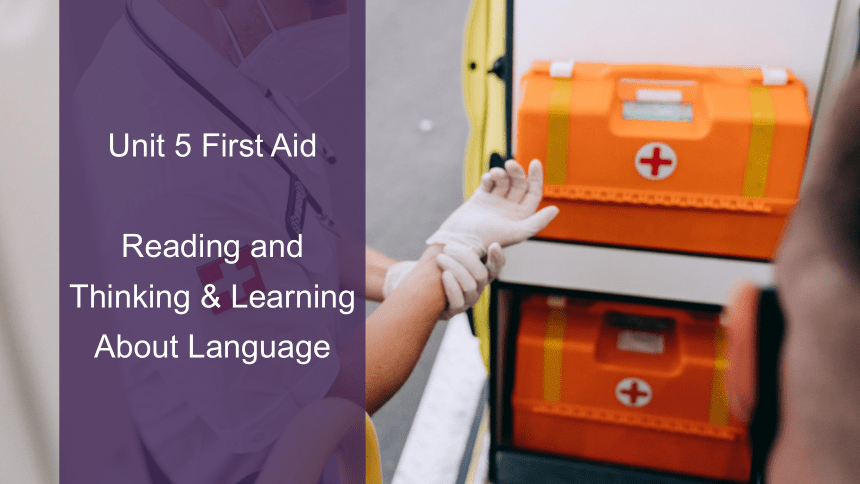 | |
| 格式 | pptx | ||
| 文件大小 | 3.1MB | ||
| 资源类型 | 教案 | ||
| 版本资源 | 人教版(2019) | ||
| 科目 | 英语 | ||
| 更新时间 | 2023-06-13 15:15:04 | ||
图片预览

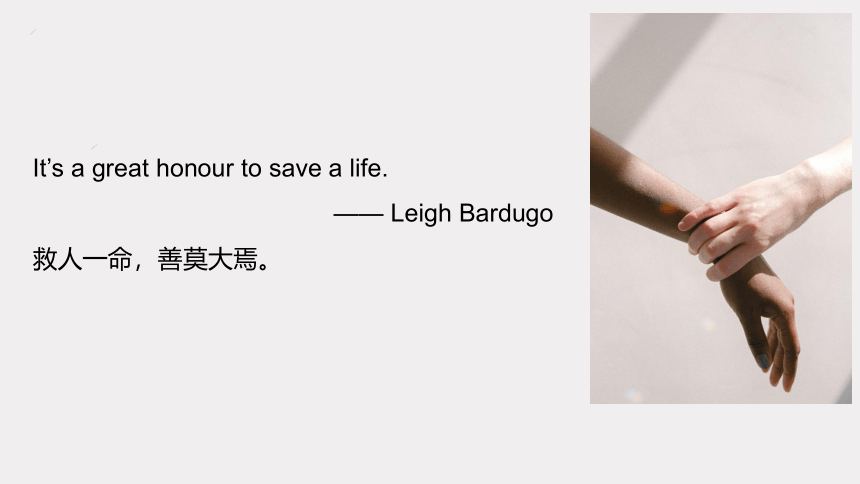
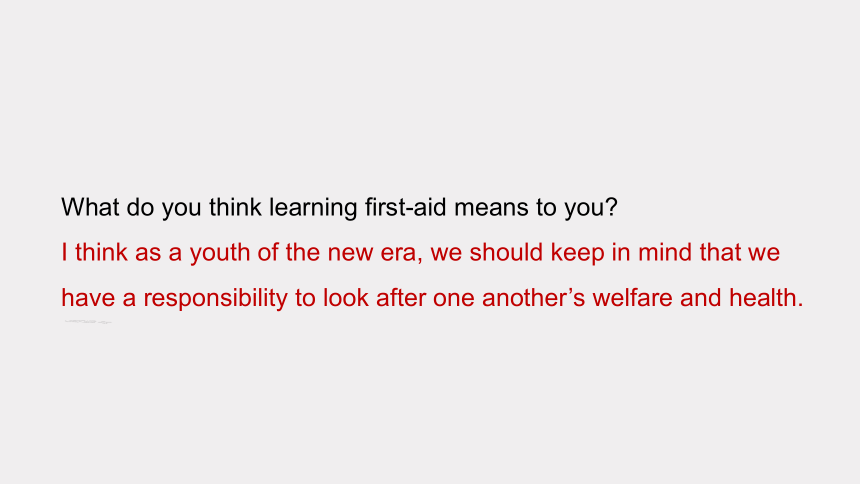
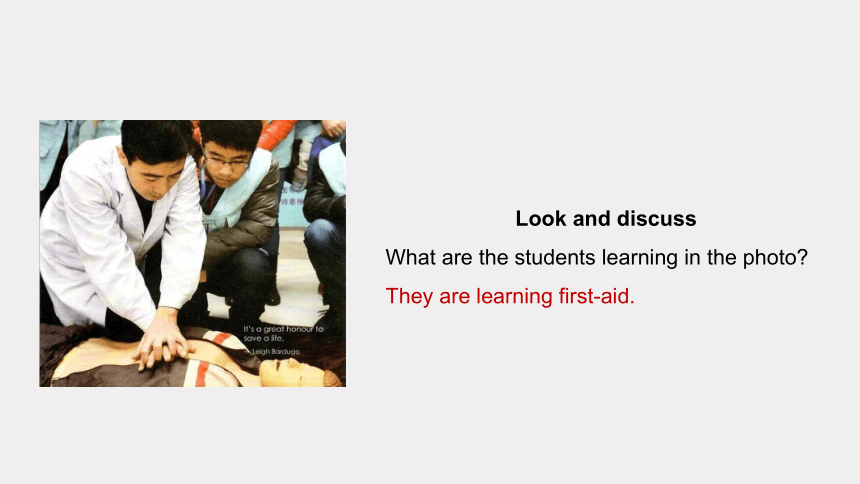
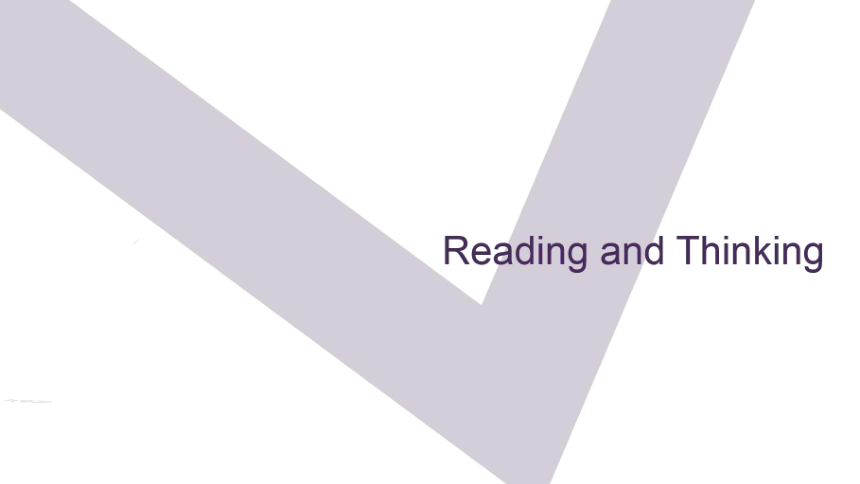
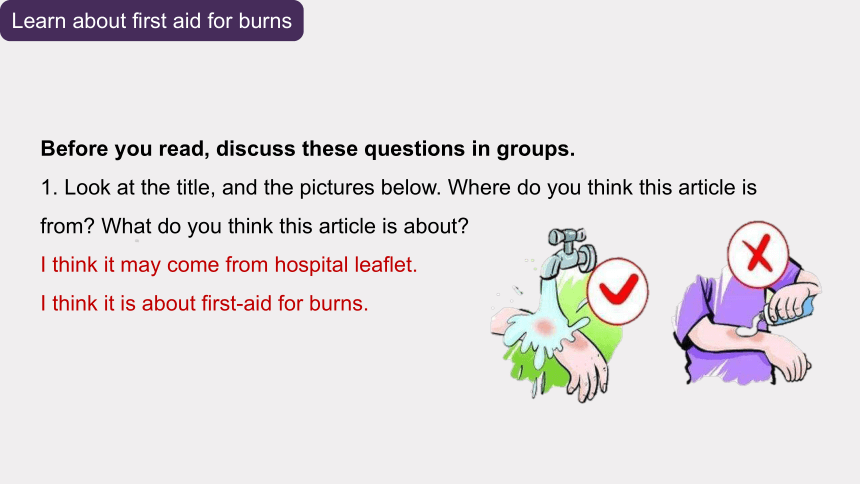

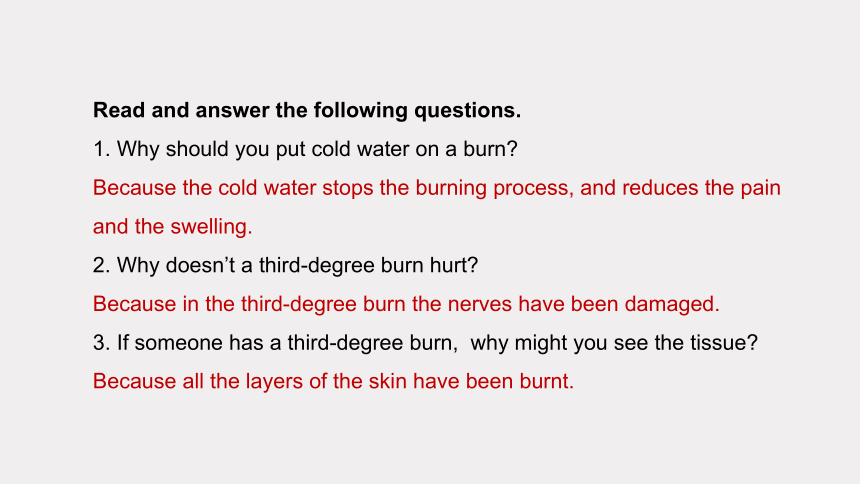
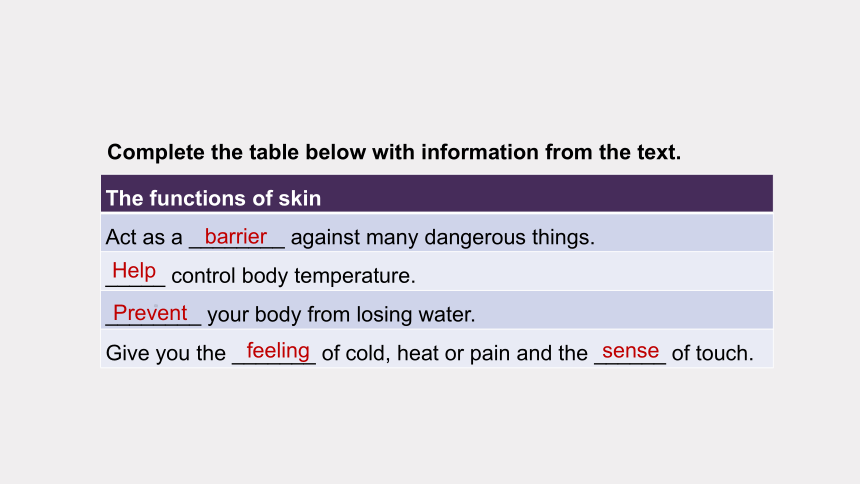

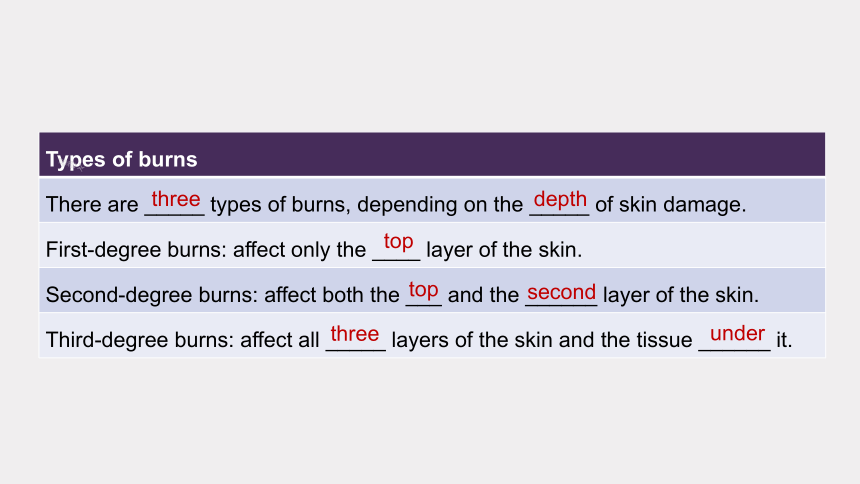
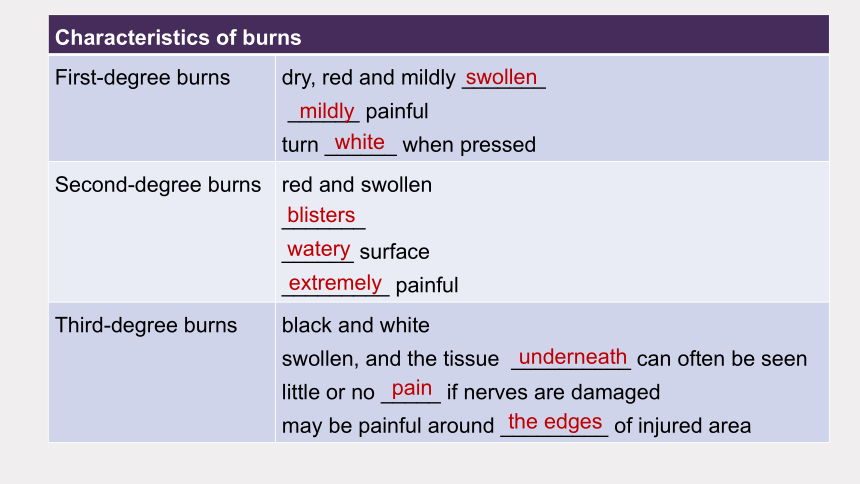
文档简介
(共30张PPT)
Unit 5 First Aid
Reading and Thinking & Learning About Language
It’s a great honour to save a life.
—— Leigh Bardugo
救人一命,善莫大焉。
What do you think learning first-aid means to you
I think as a youth of the new era, we should keep in mind that we have a responsibility to look after one another’s welfare and health.
Look and discuss
What are the students learning in the photo
They are learning first-aid.
Before you read, discuss these questions in groups.
1. Look at the title, and the pictures below. Where do you think this article is from What do you think this article is about
I think it may come from hospital leaflet.
I think it is about first-aid for burns.
Learn about first aid for burns
2. Look at the smaller headlines, how many topics are talked about and What are they
Four topics are talked about. They are causes of burns, types of burns, characteristics of burns and first-aid treatment.
Read and answer the following questions.
1. Why should you put cold water on a burn
Because the cold water stops the burning process, and reduces the pain and the swelling.
2. Why doesn’t a third-degree burn hurt
Because in the third-degree burn the nerves have been damaged.
3. If someone has a third-degree burn, why might you see the tissue
Because all the layers of the skin have been burnt.
The functions of skin
Act as a ________ against many dangerous things.
_____ control body temperature.
________ your body from losing water.
Give you the _______ of cold, heat or pain and the ______ of touch.
Help
Prevent
feeling
sense
barrier
Complete the table below with information from the text.
H2SO4
steam
the sun
fire
Causes of burns
hot liquids
electricity
chemical
Types of burns
There are _____ types of burns, depending on the _____ of skin damage.
First-degree burns: affect only the ____ layer of the skin.
Second-degree burns: affect both the ___ and the ______ layer of the skin.
Third-degree burns: affect all _____ layers of the skin and the tissue ______ it.
depth
three
top
top
second
three
under
Characteristics of burns
First-degree burns dry, red and mildly _______
______ painful
turn ______ when pressed
Second-degree burns red and swollen
_______
______ surface
_________ painful
Third-degree burns black and white
swollen, and the tissue __________ can often be seen
little or no _____ if nerves are damaged
may be painful around _________ of injured area
swollen
mildly
white
blisters
watery
extremely
underneath
pain
the edges
First-aid treatment
1. Place burns under ________________, especially within the first ten minutes.
2. _____ the burnt area gently with a _____ cloth.
3. _______ clothing near the burns.
4. _____ the burnt area with a _____ clean cloth.
5. If burns are on the face, make sure the victim can still _______.
6. _____ the victim to the doctor or hospital, if burns are second or third-degree.
Remove
cool running water
Dry
Cover
Get
clean
breathe
loose
Sum up the structure of the text.
Part 1: The functions of the skin
Part 2: Causes of burns
Part 3: Types of burns
Part 4: Characteristics of burns
Part 5: First-aid treatment
The summary of the text.
As the largest organ of your body, your skin not only protects you against diseases, but also gives you your sense of touch. So if your skin gets burnt, the first and most important step is first-aid.
Burns are divided into three types, depending on the depth of skin damage.
Different degree burns can be treated in different ways. If the burn is serious, the victim should be sent to the hospital at once.
Write a word you have learned in this unit before each definition.
1. ______ a part of the body that has a particular purpose, such as the heart or the brain.
2. _____ a chemical , usually a liquid, which has a PH of less than seven.
3. _________ one thousandth of a metre
4. _________ energy send out in waves
5. ________ material used for making cloth, curtains, etc.
6. _________ a person who has been attacked, injured, or killed
organ
millimetre
radiation
acid
fabric
victim
Choose the right word(s) from A-C to complete each short conversation.
1. A: The price for this car Fifteen thousand dollars out the door! What a deal!
B: Well, if the car hadn’t been in an accident, that would be a good price, but it has a few ____ problems.
A slight B minor C tiny
2. A: Ouch! My leg really hurts!
B: Why don’t you take some medicine to ___ the pain
A reduce B relax C ease
A/B
A/C
3. A: Have you treated any real emergencies in your first-aid course at the Red Cross
B: Well, they let us ride along with some paramedics. Once, we gave first-aid to a ____ of a traffic accident before rushing him to the hospital.
A victim B patient C sufferer
A
4. A: Did you hear that three people died in a fire last night
B: What a terrible ____! How did it happen
A accident B incident C occasion
5. A: Can I see you for a moment
B: Is it a matter of ___
A urgency B emergency C seriousness
A
A
Read the passage about chemical burns and fill in the blanks with the correct forms of the words in the box.
A chemical burn occurs when your skin or eyes come into contact with an _____ or other chemicals. Such ________ can be very dangerous and require _________ attention. Chemical burns can even affect your internal ________ if the chemicals are swallowed. first-aid should be given to chemical burns immediately. For example, wrap the burnt area _______with a clean cloth if possible. It’s important to send the _____ to the hospital right away if he or she is severely burnt.
incident loose urgent organ acid victim
victim
acid
incidents
urgent
organs
loosely
根据语境及汉语提示写出正确的单词或短语。
(1)know of first-aid __________(技能)
(2)hospital______(小册子)
(3)largest _______(器官) of your body
(4)act as a barrier against disease,_______(毒素)and the sun’s _____(光线)
(5)_____________(触觉)
(6)get burnt by _________(辐射),electricity and _______(酸)
techniques
leaflet
organ
toxins
radiation
sense of touch
rays
acids
(7)the top few __________(毫米) of skin
(8)______(轻微的) household incidents
(9)top ______(表层) of the skin
(10)burns caused by _____________(触电)
(11)the______(患者) with severe internal injuries
(12)dry, red and mildly _______(肿胀)
(13)full of _______(水泡)
(14)see the tissue ___________(隐藏在下面)
millimetres
minor
victim
layer
blisters
electric shocks
swollen
underneath
(15) damage _______(神经)
(16)see the _____(布料) sticking to the burnt skin
(17)a ______(宽松的) clean cloth
(18)There is an _______(紧急) need to take him to the hospital.
(19 )______(缓解) the pain
(20)ride along with some __________(急救医生)
(21)__________________(接触到) an acid
(22)_______(吞下) the chemicals
(23)_____(包) the burnt area loosely
fabric
urgent
loose
ease
paramedics
come into contact with
swallow
wrap
nerves
重点精析
1. You can get burnt by a variety of things: ...
你可能会被各种各样的东西烧伤: ……
get burnt 被烧伤,该结构为“get+过去分词”表示被动
a variety of =varieties of/various/all kinds of 各种各样的;不同种类的
He didn’t get paid much but it was all good experience.
他得到的报酬虽然不高,但有极好的体验。
The girls come from a variety of different backgrounds.
女孩们来自各种不同的背景。
完成句子。
(1) I __________ in the rain on the way home.
我在回家的路上遇到倾盆大雨。
(2) She nearly ______ by a car.
她差点被汽车撞了。
(3) There are ____________________________ ways of cooking an egg.
有各种各样的方法煮鸡蛋。
got caught
got hit
various/a variety of/varieties of
2. Remove any clothes using scissors if necessary, unless you see the fabric sticking to the burnt skin.
如果有必要,用剪刀剪掉烧伤部位的衣服,除非衣服与被烧伤的皮肤粘在一起。
句式分析: 本句是个复合句。
主句Remove any clothes是祈使句;
unless引导的是条件状语从句;
if necessary是省略句,表示“如果有必要的话”, 完整的形式是if it is necessary;
unless除非;如果不,引导一个肯定的条件状语从句,从句有时可与if...not引导的否定状语从句互换。
If necessary, the patient can then visit his doctor for further advice.
如有必要,病人可以上门咨询自己的医生以得到更多的建议。
You won’t make friends with them unless you care for the people under great pressure.
除非你关心那些处于巨大压力下的人,否则你不会和他们成为朋友。
知识拓展:if构成的其他省略形式
if any 如果有的话
if possible 如果有可能的话
if so 如果是这样的话
if ever 如果曾经有的话
if not 如果不这样的话
Homework
Review what we have learnt and repeat the text with your own words.
Unit 5 First Aid
Reading and Thinking & Learning About Language
It’s a great honour to save a life.
—— Leigh Bardugo
救人一命,善莫大焉。
What do you think learning first-aid means to you
I think as a youth of the new era, we should keep in mind that we have a responsibility to look after one another’s welfare and health.
Look and discuss
What are the students learning in the photo
They are learning first-aid.
Before you read, discuss these questions in groups.
1. Look at the title, and the pictures below. Where do you think this article is from What do you think this article is about
I think it may come from hospital leaflet.
I think it is about first-aid for burns.
Learn about first aid for burns
2. Look at the smaller headlines, how many topics are talked about and What are they
Four topics are talked about. They are causes of burns, types of burns, characteristics of burns and first-aid treatment.
Read and answer the following questions.
1. Why should you put cold water on a burn
Because the cold water stops the burning process, and reduces the pain and the swelling.
2. Why doesn’t a third-degree burn hurt
Because in the third-degree burn the nerves have been damaged.
3. If someone has a third-degree burn, why might you see the tissue
Because all the layers of the skin have been burnt.
The functions of skin
Act as a ________ against many dangerous things.
_____ control body temperature.
________ your body from losing water.
Give you the _______ of cold, heat or pain and the ______ of touch.
Help
Prevent
feeling
sense
barrier
Complete the table below with information from the text.
H2SO4
steam
the sun
fire
Causes of burns
hot liquids
electricity
chemical
Types of burns
There are _____ types of burns, depending on the _____ of skin damage.
First-degree burns: affect only the ____ layer of the skin.
Second-degree burns: affect both the ___ and the ______ layer of the skin.
Third-degree burns: affect all _____ layers of the skin and the tissue ______ it.
depth
three
top
top
second
three
under
Characteristics of burns
First-degree burns dry, red and mildly _______
______ painful
turn ______ when pressed
Second-degree burns red and swollen
_______
______ surface
_________ painful
Third-degree burns black and white
swollen, and the tissue __________ can often be seen
little or no _____ if nerves are damaged
may be painful around _________ of injured area
swollen
mildly
white
blisters
watery
extremely
underneath
pain
the edges
First-aid treatment
1. Place burns under ________________, especially within the first ten minutes.
2. _____ the burnt area gently with a _____ cloth.
3. _______ clothing near the burns.
4. _____ the burnt area with a _____ clean cloth.
5. If burns are on the face, make sure the victim can still _______.
6. _____ the victim to the doctor or hospital, if burns are second or third-degree.
Remove
cool running water
Dry
Cover
Get
clean
breathe
loose
Sum up the structure of the text.
Part 1: The functions of the skin
Part 2: Causes of burns
Part 3: Types of burns
Part 4: Characteristics of burns
Part 5: First-aid treatment
The summary of the text.
As the largest organ of your body, your skin not only protects you against diseases, but also gives you your sense of touch. So if your skin gets burnt, the first and most important step is first-aid.
Burns are divided into three types, depending on the depth of skin damage.
Different degree burns can be treated in different ways. If the burn is serious, the victim should be sent to the hospital at once.
Write a word you have learned in this unit before each definition.
1. ______ a part of the body that has a particular purpose, such as the heart or the brain.
2. _____ a chemical , usually a liquid, which has a PH of less than seven.
3. _________ one thousandth of a metre
4. _________ energy send out in waves
5. ________ material used for making cloth, curtains, etc.
6. _________ a person who has been attacked, injured, or killed
organ
millimetre
radiation
acid
fabric
victim
Choose the right word(s) from A-C to complete each short conversation.
1. A: The price for this car Fifteen thousand dollars out the door! What a deal!
B: Well, if the car hadn’t been in an accident, that would be a good price, but it has a few ____ problems.
A slight B minor C tiny
2. A: Ouch! My leg really hurts!
B: Why don’t you take some medicine to ___ the pain
A reduce B relax C ease
A/B
A/C
3. A: Have you treated any real emergencies in your first-aid course at the Red Cross
B: Well, they let us ride along with some paramedics. Once, we gave first-aid to a ____ of a traffic accident before rushing him to the hospital.
A victim B patient C sufferer
A
4. A: Did you hear that three people died in a fire last night
B: What a terrible ____! How did it happen
A accident B incident C occasion
5. A: Can I see you for a moment
B: Is it a matter of ___
A urgency B emergency C seriousness
A
A
Read the passage about chemical burns and fill in the blanks with the correct forms of the words in the box.
A chemical burn occurs when your skin or eyes come into contact with an _____ or other chemicals. Such ________ can be very dangerous and require _________ attention. Chemical burns can even affect your internal ________ if the chemicals are swallowed. first-aid should be given to chemical burns immediately. For example, wrap the burnt area _______with a clean cloth if possible. It’s important to send the _____ to the hospital right away if he or she is severely burnt.
incident loose urgent organ acid victim
victim
acid
incidents
urgent
organs
loosely
根据语境及汉语提示写出正确的单词或短语。
(1)know of first-aid __________(技能)
(2)hospital______(小册子)
(3)largest _______(器官) of your body
(4)act as a barrier against disease,_______(毒素)and the sun’s _____(光线)
(5)_____________(触觉)
(6)get burnt by _________(辐射),electricity and _______(酸)
techniques
leaflet
organ
toxins
radiation
sense of touch
rays
acids
(7)the top few __________(毫米) of skin
(8)______(轻微的) household incidents
(9)top ______(表层) of the skin
(10)burns caused by _____________(触电)
(11)the______(患者) with severe internal injuries
(12)dry, red and mildly _______(肿胀)
(13)full of _______(水泡)
(14)see the tissue ___________(隐藏在下面)
millimetres
minor
victim
layer
blisters
electric shocks
swollen
underneath
(15) damage _______(神经)
(16)see the _____(布料) sticking to the burnt skin
(17)a ______(宽松的) clean cloth
(18)There is an _______(紧急) need to take him to the hospital.
(19 )______(缓解) the pain
(20)ride along with some __________(急救医生)
(21)__________________(接触到) an acid
(22)_______(吞下) the chemicals
(23)_____(包) the burnt area loosely
fabric
urgent
loose
ease
paramedics
come into contact with
swallow
wrap
nerves
重点精析
1. You can get burnt by a variety of things: ...
你可能会被各种各样的东西烧伤: ……
get burnt 被烧伤,该结构为“get+过去分词”表示被动
a variety of =varieties of/various/all kinds of 各种各样的;不同种类的
He didn’t get paid much but it was all good experience.
他得到的报酬虽然不高,但有极好的体验。
The girls come from a variety of different backgrounds.
女孩们来自各种不同的背景。
完成句子。
(1) I __________ in the rain on the way home.
我在回家的路上遇到倾盆大雨。
(2) She nearly ______ by a car.
她差点被汽车撞了。
(3) There are ____________________________ ways of cooking an egg.
有各种各样的方法煮鸡蛋。
got caught
got hit
various/a variety of/varieties of
2. Remove any clothes using scissors if necessary, unless you see the fabric sticking to the burnt skin.
如果有必要,用剪刀剪掉烧伤部位的衣服,除非衣服与被烧伤的皮肤粘在一起。
句式分析: 本句是个复合句。
主句Remove any clothes是祈使句;
unless引导的是条件状语从句;
if necessary是省略句,表示“如果有必要的话”, 完整的形式是if it is necessary;
unless除非;如果不,引导一个肯定的条件状语从句,从句有时可与if...not引导的否定状语从句互换。
If necessary, the patient can then visit his doctor for further advice.
如有必要,病人可以上门咨询自己的医生以得到更多的建议。
You won’t make friends with them unless you care for the people under great pressure.
除非你关心那些处于巨大压力下的人,否则你不会和他们成为朋友。
知识拓展:if构成的其他省略形式
if any 如果有的话
if possible 如果有可能的话
if so 如果是这样的话
if ever 如果曾经有的话
if not 如果不这样的话
Homework
Review what we have learnt and repeat the text with your own words.
